Range 2,037 km Weight 1,681 kg Length 9.4 m | Top speed 556 km/h Wingspan 12 m Engine type Williams FJ33 | |
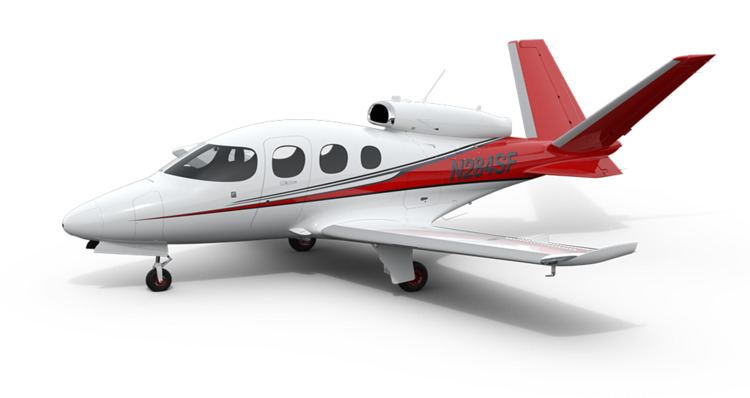 | ||
Unit cost 1,960,000–1,960,000 USD (2013) | ||
New mini episode the personal jet set cirrus vision sf50 with g3000 touchscreen operations
The Cirrus Vision SF50 is a single-engine, low-wing, seven-seat, very light jet aircraft designed and produced by Cirrus Aircraft. The aircraft was initially developed under the project name "The Jet", but Cirrus announced the marketing name of "Vision SJ50" on July 9, 2008. In March 2009, the aircraft was redesignated the "Vision SF50".
Contents
- New mini episode the personal jet set cirrus vision sf50 with g3000 touchscreen operations
- X plane 11 beta cirrus vision sf50 phnl to phog vfr vhf navigation
- Design and development
- 2006
- 2007
- 2008
- 2009
- 2010
- 2012
- 2013
- 2014
- 2015
- 2016
- Operators
- Specifications Vision SF50
- References
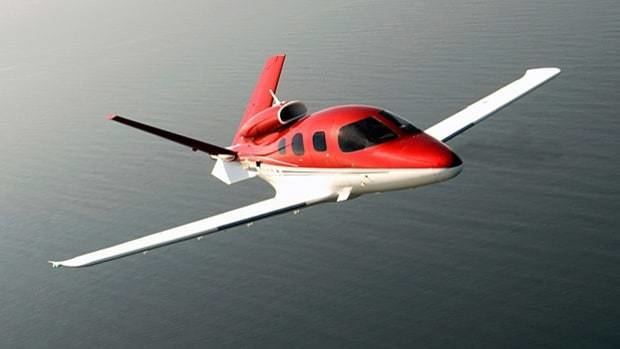
The prototype aircraft was first shown publicly at the annual Cirrus Migration on June 26, 2008, and first flown on July 3, 2008. The SF50 is intended to be a step up aircraft for pilots who have flown the Cirrus SR20, SR22 and other high-performance light aircraft.
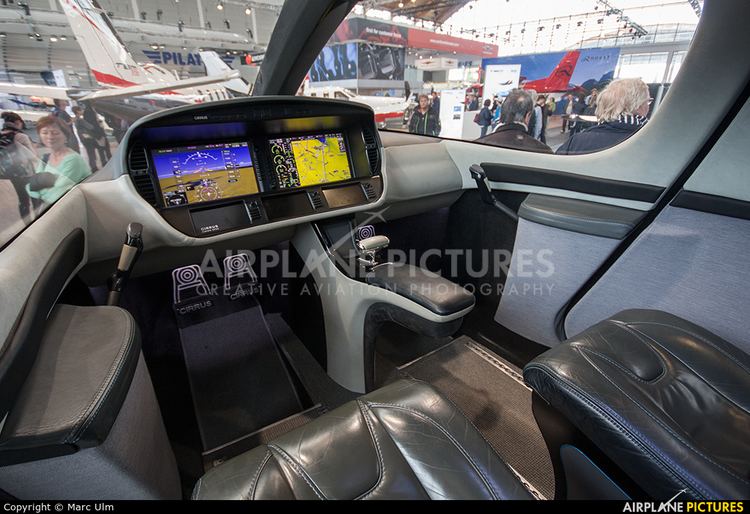
The aircraft was Federal Aviation Administration type certified on 28 October 2016, after a ten year development process, marked by aircraft technical and company financial challenges.
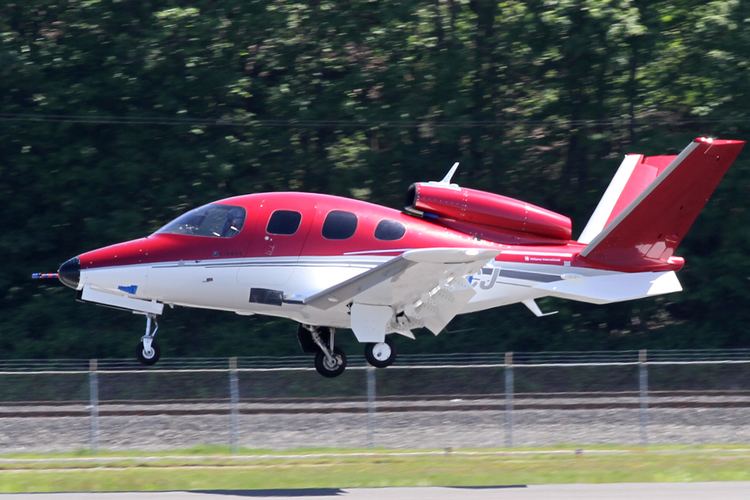
X plane 11 beta cirrus vision sf50 phnl to phog vfr vhf navigation
Design and development
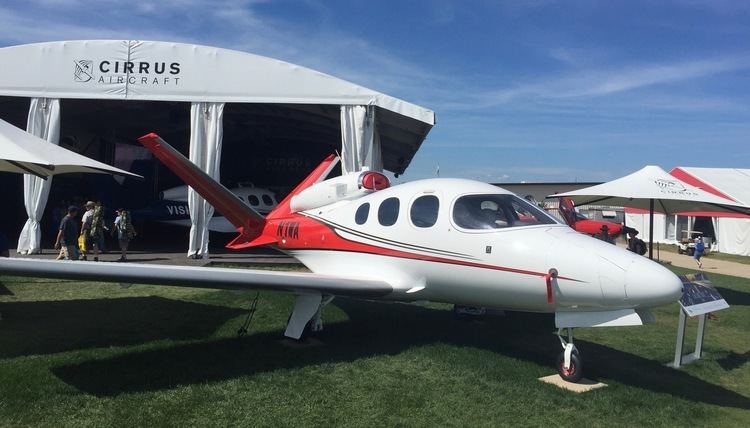
The Vision SF50 is a low-wing cantilever monoplane made of composite material and powered by a single Williams FJ33 turbofan mounted above the rear fuselage. It has a v-tail and a retractble tricycle landing gear. The enclosed cabin is 5.1 ft (1.56 m) wide and is 4.1 ft (1.24 m) high with room for seven. Access to the cabin is through a clamshell door on the left hand side.
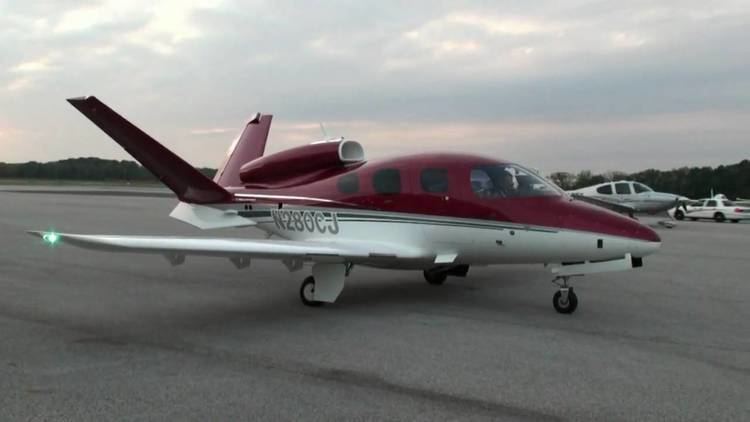
The SF50 is equipped with the CAPS parachute, making it the first jet of any kind to come with a whole aircraft ballistic parachute. It is also considered the first civilian single-engine jet to achieve certification with the FAA. The SF50 is designed for 12,000 flight hours.
2006
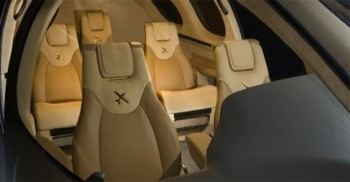
Cirrus began taking US$100,000 deposits for the aircraft in 2006. Initially, as a public relations exercise, the company gave deposit holders a drawing of the aircraft in the form of a jigsaw puzzle, one piece at a time. On 28 June 2007, the entire puzzle was completed and the aircraft's configuration was unveiled.
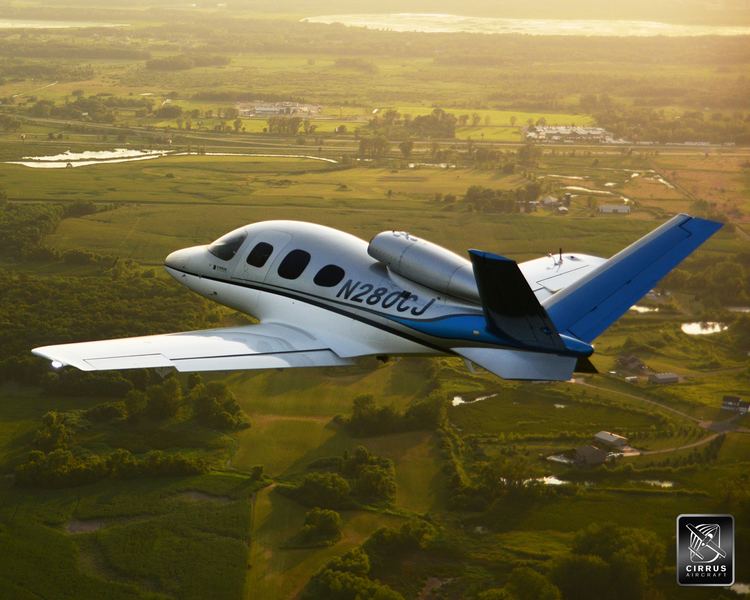
In December 2006, Cirrus announced that its product will be the "slowest, lowest, and cheapest jet available." The SF50 will be powered by a single Williams FJ33-4A-19 engine, producing 1,900 pounds-force (8,500 N) of thrust and is expected to cruise at about 300 knots (560 km/h). The SF50 will seat seven people, with the cockpit, second row and the third row each seating two. There will be a seat that can slide between the second and third row or be removed entirely. The parachute will be located in the nose.
2007
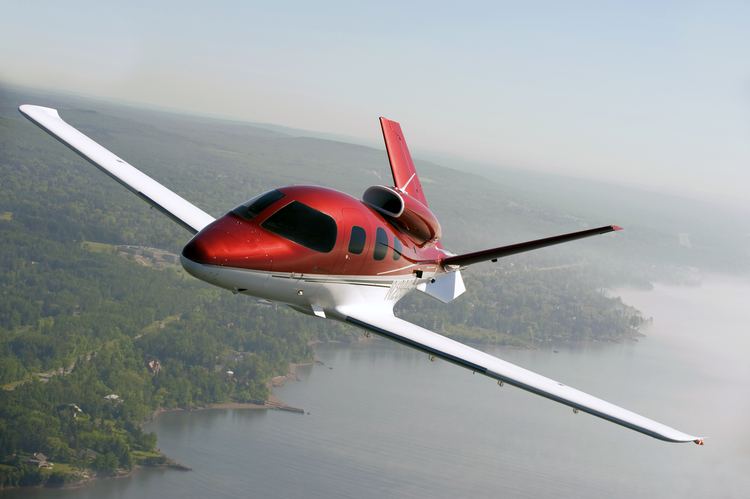
On December 27, 2007 Cirrus Design secured a lease for the former Northwest Airlines hangar at Duluth International Airport in Duluth, Minnesota, indicating that it will use the 189,000-square-foot (17,600 m2) building for construction of the new jet. The lease was canceled in 2009 during the height of the Great Recession.
2008
On 22 May 2008, at EBACE 2008, Cirrus CEO Alan Klapmeier confirmed that the company currently has 400 refundable deposits of US$100,000 for the aircraft. The jet took its first flight on 3 July 2008 at the Duluth airport.
On 3 December 2008, CEO Alan Klapmeier and Vice President for Advanced Development Mike Van Staagen provided an update on the aircraft's development. Klapmeier confirmed that the SF50 is not intended for corporate or air-taxi use, but is being developed for personal-use and that market will determine the design. Klapmeier confirmed that the prototype has flown 120 hours and that expectations have been met. Completed test flying includes proving the whole center of gravity envelope, in-flight engine shut-down and restart. He confirmed that stall testing is still being conducted.
The aircraft's aerodynamic design has been modified based on the test flights completed and the use of computer models with the aim of increasing performance. Changes include altering the engine thrust angle, which has made a large improvement. On the final production aircraft the right side door has been eliminated to save weight. The door will be replaced by an emergency egress hatch. The production aircraft will also have a more pointed nose, larger belly section, redesigned wing-root fairing, reduced tail sweep and a larger or even dual ventral fin.
Klapmeier confirmed that the aircraft's maximum payload will be 1,200 pounds. With full fuel it will carry 400 pounds of people and cargo. Klapmeier indicated that the trade-off between range and payload was based on customer consultations, which indicated that owners will often fly longer trips solo. Target range will be 1,100 nmi (2,037 km) at a maximum cruise speed of 300 kn (556 km/h). He also indicated that an Federal Aviation Administration type certificate application will be ready in mid-December 2008 but, due to high fees on this class of aircraft in Europe, European Aviation Safety Agency certification will not be sought immediately. Klapmeier indicated that the fees EASA charges to certify an aircraft are unreasonable. The FAA does not charge any fees to certify an aircraft. Klapmeier stated: "We're not filing because we're not paying."
Cirrus announced that pilot training requirements will be specified in the type certificate, in a similar manner to the Eclipse 500, making training a legal requirement.
In December 2008 the price for the SF50 was estimated to be US$1 million (base) and US$1.25 Million (equipped) when production commences.
2009
The L-3 SmartDeck was used as the avionics package during the development phase of the SF50 but was replaced with the Garmin G1000 for the development version. As a result of this change L-3 Avionic Systems announced in June 2009 that they are suing Cirrus for US$18M.
On 26 June 2009 it was reported by AVweb that Cirrus Design co-founder and former CEO Alan Klapmeier intended to buy the SF50 project from Cirrus Design and its major shareholder Arcapita and produce the aircraft himself under a new company. The new venture received financial advice from Merrill Lynch. Klapmeier indicated that his reason for wanting to take over the project was to increase the speed of development. Current Cirrus CEO Brent Wouters responded by saying that the company intends to proceed with the SF50 program itself, but would listen to Klapmeier's proposal.
On 27 July 2009 Cirrus CEO Brent Wouters and co-founder Dale Klapmeier stated at a press conference that they would find a way to produce the SF50, either at Cirrus or through selling it to Alan Klapmeier. They both indicated that the key factor was raising enough capital to proceed with the project, complete certification and commence production.
On 31 July 2009 Alan Klapmeier announced that his offer to buy the SF50 program had not succeeded, with the key issue the program selling price, as well as other points and that the negotiations were at an end. Wouters responded saying further talks were possible, but that Cirrus would continue to develop the SF50 in house.
In July 2009 the company announced that the test program had completed 200 hours of flight time. The aircraft incorporated some design changes, including an X tail, simpler and lighter flaps and changes to the handling so that the aircraft pitches up on power application instead of down. The company confirmed at that time that they had about 400 orders for the aircraft, although some deposit refunds have been issued. First deliveries were anticipated in 2012, subject to capital funding.
On 2 September 2009 Cirrus announced that the maximum price for purchasers who have already paid a deposit was US$1.39M. This will provide customers with an aircraft equipped to a similar standard as the current SR22 GTS model. For new customers who paid a US$100,000 deposit before the end of 2009 the price was US$1.55M. Beginning on 1 January 2010 the price will be US$1.72M, with a US$50,000 deposit, all in 2009 dollars.
In November 2009 the company announced that development of the SF50 had slowed due to inability to raise the capital needed in the post-test flying phase. Cirrus CEO Brent Wouters indicated that the lack of financing would move deliveries into 2012 or later.
2010
In January 2010 Cirrus confirmed that the project does not have a timeline for certification or deliveries. CEO Brent Wouters stated: "It's a function of cash flow ... We will get the program done as soon as humanly possible." As of January 2010 the company had 428 position holders, with orders increasing at about one to two per week. The test aircraft had accumulated 236 hours. Also in January 2010 some parameters for the jet's design were confirmed. The aircraft will be certified for FL280. It will have a hybrid ice protection system consisting of urethane pneumatic boots. The cabin pressurization will be contained within a single-piece carbon shell. The aircraft will have an optional lavatory and will fit in a standard US-style 40 ft (12 m) Tee hangar.
In June 2010 the company announced that it expected to start building a conforming prototype by the end of 2010 and having it flying by the end of 2011. Certification at that time was forecast for the middle of 2013. The company is also proceeding with the full-aircraft parachute design, a component that company CEO Wouters described as "high-risk".
As of June 2010 Cirrus reported that they had 431 orders for the aircraft, which was priced at US$1.72M at that time. Deposits made after 1 January 2010 were made non-refundable.
2012
The company announced in April 2012 that the SF50 project had received sufficient investment from Cirrus's new owners, China Aviation Industry General Aircraft (CAIGA), and, as a result, the project would proceed. In July 2012 company CEO Dale Klapmeier confirmed that Cirrus's new Chinese owners are dedicated to the SF-50 and that the prototype had flown 600 hours in almost 600 flights. The company was proceeding to build the composite construction tooling required to create a conforming prototype for the commencement of type certification flight testing. The conforming prototype is expected to have its first flight in late 2013.
2013
By February 2013 the company was hiring staff for the production of the aircraft. The new price at this point was US$1.96M.
In April 2013 Meng Xiangkai, Chairman of CAIGA, the owner of Cirrus, announced that the newest prototype version of the SF50 would be rolled out during 2013 and that certification flight testing would commence in 2014.
In October 2013 Cirrus announced that with the new Chinese investment three prototypes were under construction for certification flight testing during 2014. First customer deliveries were scheduled for 2015 against a paid deposit order book of 500 aircraft.
2014
By February 2014 a total of 800 hours of test flying had been completed. On 24 March 2014 the first conforming prototype flew. The prototype was displayed at the Oshkosh Airshow that summer. Pre-orders were 550 at a price below $2 million, and Cirrus intends to produce up to 125 per year. The second conforming test aircraft flew in November 2014 and the third (and final) one made its first flight on 20 December 2014.
2015
In February 2015 the City of Duluth had agreed to put up US$6M and had asked the state contribute the remaining US$4M to build a US$10M factory on the Duluth Airport dedicated to the production of SF50 Vision jets. The city would then try to recoup its costs for the facility from lease payments by Cirrus over time. The city is concerned that without the government support Cirrus will locate jet production elsewhere due to better incentives. This was confirmed by Cirrus CEO Dale Klapmeier and Duluth Mayor Don Ness, who both indicated that time is running out for the state to commit funds.
In April 2015 the first production aircraft was being assembled. The company expressed confidence that certification would proceed on schedule and without need for modifications and decided to start production against the demand for 550 customer aircraft already ordered.
In September 2015 the Cirrus Perspective Touch glass cockpit by Garmin was finalized. It will feature a large primary flight display and multi-function display, including three smaller controllers, all with touchscreen capabilities.
2016
In January 2016 the company announced that delays had moved certification from 2015 to the first half of 2016, citing inflight ballistic parachute testing as one of their final tasks before FAA approval. In March 2016 the FAA announced that since the parachute system was not required for certification, the company did not have to conduct an in-flight parachute deployment demonstration. Flying magazine reported that "Cirrus might still decide to test the parachute in flight", despite the FAA's notice.
The first production aircraft flew on 5 May 2016 and at that time certification was forecast to be completed in June 2016. The selected engine, the Williams FJ33-5A, was approved by the FAA on 6 June 2016. By July 2016, the SF50 had over 600 orders, the four flight test aircraft had flown more than 1,700 hours and certification was then planned for the fourth quarter of 2016, delayed from the previous estimate of mid-2016.
FAA certification was completed on 28 October 2016. The first customer Vision SF50 was delivered on 19 December 2016.
Operators
In July 2008, SATSair, an air taxi company 25% owned by Cirrus, ordered five Cirrus Vision SF50s, intending to add them to its fleet of Cirrus SR22 piston aircraft. SATSair subsequently ceased operations on 24 October 2009, prior to taking delivery of any SF50s.
Specifications (Vision SF50)
Data from Brochure, Cirrus
General characteristics
Performance
Avionics
